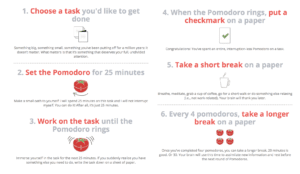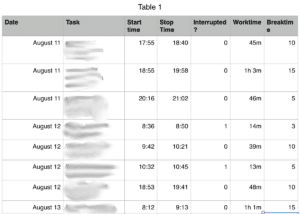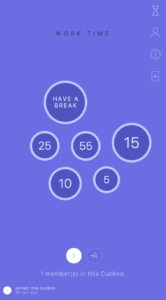Why You Should Use the Pomodoro Technique | Study Skills
5 min read•july 11, 2024
S
Sally Kim
General 🙋
23 resourcesSee Units
In my last blog post, I briefly mentioned the Pomodoro Technique, an awesome technique to use in studying... but how exactly does this technique help us work more efficiently?
Basics

Courtesy of Cirillo Consulting
Pomodoro Technique is a process developed by Francesco Cirillo. It is designed to help people focus on their work and manage their time.
One round consists of a 25-minute working period followed by a 5-minute break. Every four rounds are followed by a longer break, ranging from 20 to 30 minutes. Then, the same process is repeated over and over again until the work has been finished. Each round is considered as a pomodoro.
Variations
It is really up to you to decide how long you want your working periods and breaks! Here are some more common ways than the usual pomodoro to split up your time:
90 Minute
I work for 90 minutes because that’s what the research suggests is the optimal human limit for focusing intensely on any given task.
In a Harvard Business Review article called "A 90-Minute Plan for Personal Effectiveness," Tony Schwartz, founder of The Energy Project, writes that we tend to ignore when the body attempts to tell us to take breaks through signs, such as drowsiness and restlessness. Instead, we try to overcome these signs through other ways, like caffeine. Schwartz found that when he learned to listen to what his body was saying, he often took a break after about 90 minutes. Even if he feels that he can keep going past the 90-minute mark, he still takes a break because it will end up impacting his work later on if he doesn't.
52 and 17
Julia Gifford, who works at The Draugiem Group, explains how workers can work most productively in her The Muse article, "The Rule of 52 and 17: It's Random, But it Ups Your Productivity."
Turns out, what the most productive 10% of our users have in common is their ability to take effective breaks. Specifically, the most productive people work for 52 minutes at a time, then break for 17 minutes before getting back to it.
Gifford describes that during the 52-minute period of work, people must work with a purpose, but they should be completely detached from their work during break time. Taking a break doesn't mean looking at social media, either. This technique focuses on switching between the opposite ends: work to rest, back and forth.
Flowtime
In a Medium article, "The Flowtime Technique," Zöe Read Bivens describes a similar system that she developed to help fit her work more.

Courtesy of LightsAndCandy on Medium
Bivens was unsatisfied with the pomodoro breaking her focus, especially on tasks that require creativity or innovation. So, she invented her own technique where she first makes a list of tasks and starts on the first task. She records the start time and continuously works. The most important part here is that she enforces taking a break whenever you feel like taking a break. Once Bivens takes a break, she records down the stop time as well as the break time. If she was interrupted while she was working, she would mark down the task as interrupted and stop it.
You can record your Work Time (in minutes) as you go, or when you finish a task, or even at the end of the day. This is important data you can use to plan your day, notice your most productive times, and notice any correlation between lengths of breaks and sustained work time.
Why It Works
Many research has shown that taking breaks is necessary for the brain to get some rest.
An article on Psychology Today called "How Do Work Breaks Help Your Brain? 5 Surprising Answers" explains that a part of the brain is responsible for helping us not only concentrate but also think logically and have strong willpower. When we work for too long, our brains get tired and we become more sluggish. Taking breaks allows us to refresh ourselves. The article also mentions that breaks can restore motivation and boost our creativity once we go back to our work.
Suggested Apps/Websites
Fiveable is not associated with or sponsored by any of the products or companies listed below. The opinions and personal insights stated reflect those of the blogger and not of Fiveable.
Finding a good timer for yourself may be difficult, so I've listed some apps and websites that I've liked and preferred below.
Cuckoo

Screenshot of Cuckoo
Cuckoo allows people to work in groups. By sharing a link, you can join your friends in completing a pomodoro together.
One aspect that I like is that you can set up a unique time frame for each round. Its ability to be fluid helps when you need to focus shorter or longer than usual.
One downside is that the alarm doesn't always notify you, especially if you're using the website. A solution I've seen people do is to have two tabs open with the Cuckoo tab behind your other tab. By looking at the colors, you can estimate how much time you have left.
Cuckoo is free to use. It is downloadable on Mac; otherwise, it is only available on the browser.
Forest
Forest plants a tree every time you set a timer. The goal is to not use your phone during the period (or open any blacklisted tabs if using the Chrome extension). If you do decide to open your phone, the tree withers away. The maximum time you can set is 120 minutes, or 2 hours.
The app partners with a tree-planting company. If users spend virtual coins earned by planting virtual trees, a real tree will be planted. (Due to expenses, the maximum amount of real trees that a user can plant is five. However, the Forest team have mentioned that there will be future events where users can plant more than five trees.)
Forest costs $1.99 on iOS while it is free with an option of a Pro version on Android. There is also a free Chrome extension available.
Marinara Timer
Courtesy of Marinara Timer
One reason why I like Marinara Timer is that it offers three different modes as shown above. There is the standard pomodoro, the custom timer, and the kitchen timer. I find that the custom timer is really helpful if you're trying different variations of the Pomodoro technique. With its simple design, the website is very easy to navigate. There is also an option to invite your friends to your timer and work together.
Marinara Timer is free to use and is only available on the browser.
If you think about it, the Pomodoro technique is really similar to most of the study habits and techniques that teachers and educators recommend to students in school. Definitely give the apps listed above a try especially with the increasing overlap between education and technology through mobile devices, online classrooms, and the like. Remember: study smarter, not harder!
Browse Study Guides By Unit
🆕New Subjects
📂Study Skills
🎉Special Events
✏️Blogs
🎓 College Admissions
💫 Fiveable Fridays

Fiveable
Resources
© 2025 Fiveable Inc. All rights reserved.